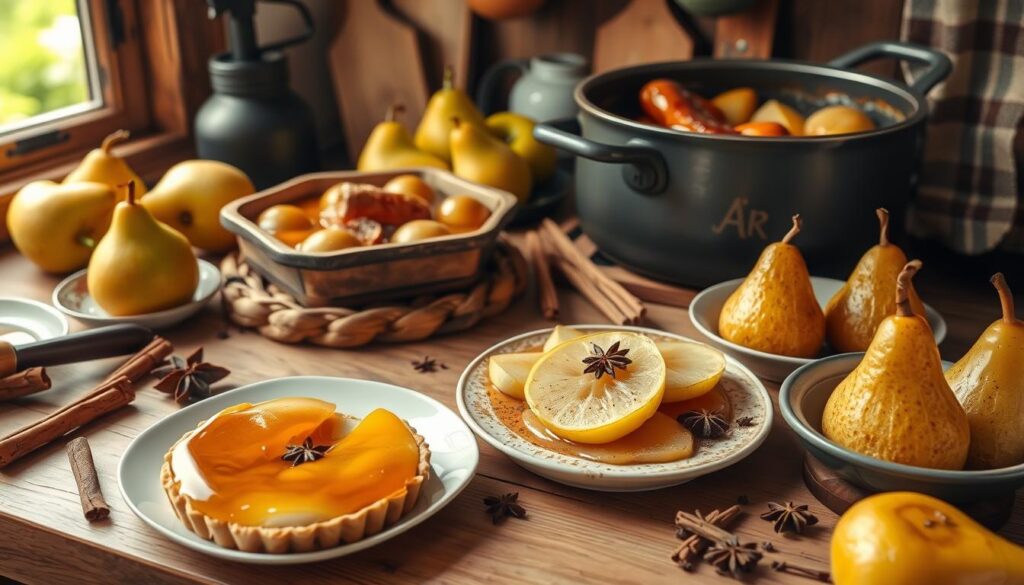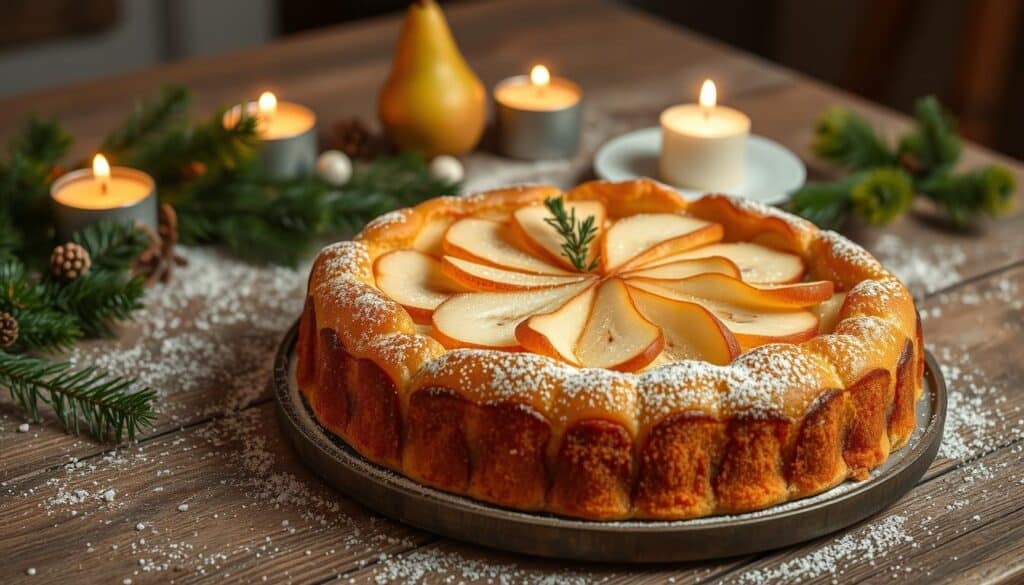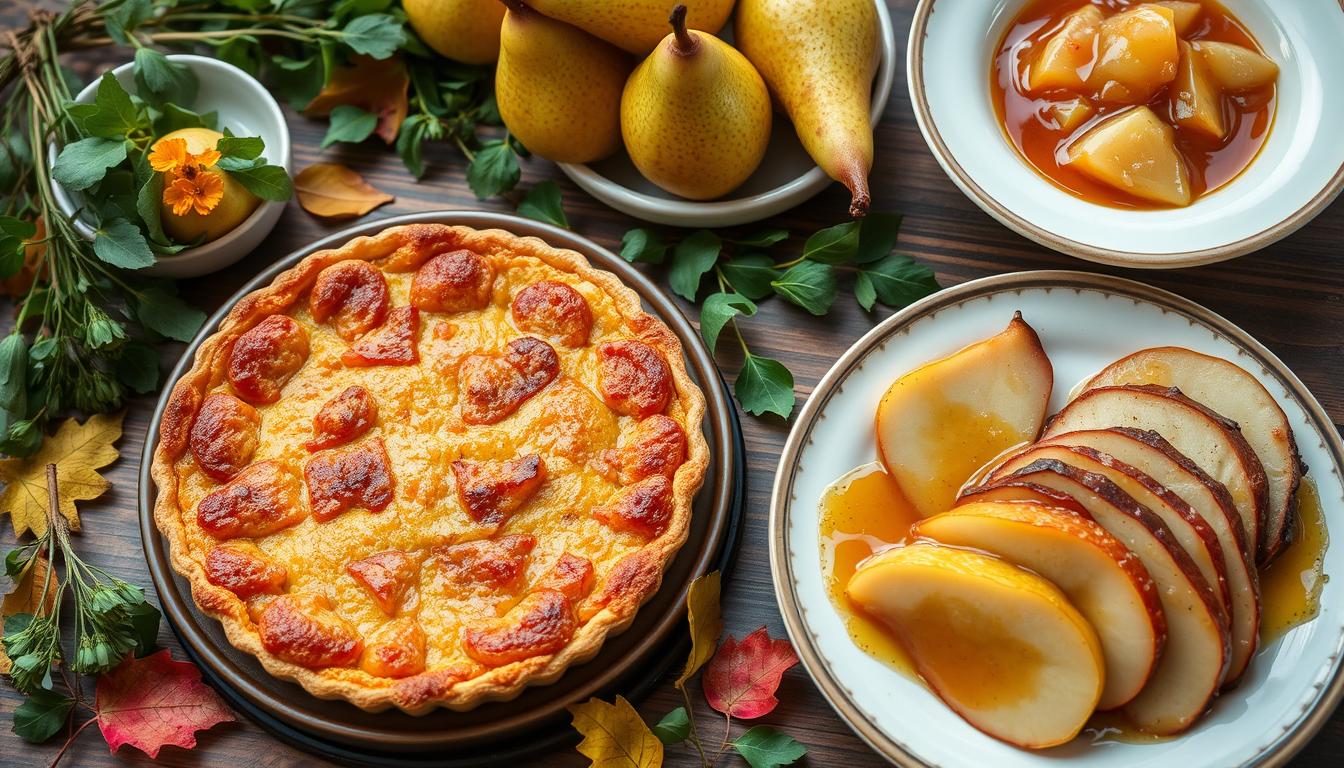I love exploring different cuisines, and German food is no exception. The way pears are used in German dishes is truly special. From the cozy Pear Strudel to the zesty Pear and Elderflower Spritz, pears add a unique touch to German cooking.
We’ll explore the world of German pear recipes together. We’ll learn about the stories, techniques, and tastes that have been shared for years. Whether you’re an expert or just starting out, let’s celebrate the special place pears hold in German cooking.
Key Takeaways
- German cuisine features a variety of pear-based dishes, both sweet and savory, that showcase the fruit’s versatility.
- Traditional German pear recipes, like Pear Strudel and Pear Tart, have been passed down through generations.
- Pears play a significant role in classic German desserts and pastries, often paired with spices, cream, and other complementary flavors.
- Pear-based drinks, such as the Pear and Elderflower Spritz, offer a modern twist on traditional German flavors.
- Exploring the history and regional variations of German pear dishes provides a deeper understanding of the country’s culinary heritage.
Introduction to German Culinary Heritage with Pears
Pears have been a big part of German food for centuries. Each area in Germany has its own special pear dishes , just like the regional versatility seen in our Dessert & Juices collection. From sweet pear desserts in Bavaria to savory dishes in northern Germany, pears have made a big impact on German food.
Historical Significance of Pears in German Cooking
Pears were first grown in Germany during the Roman times. Many types of pears were brought from France in the 13th century for cooking. The Warden pear, known for pies, came from a Cistercian Abbey near Old Warden.
But, the Warden pear almost disappeared in the 19th century. Only five trees were left in Warden, Bedfordshire. Recently, people have worked to grow more Warden pear trees by grafting.
Regional Variations Across Germany
Every part of Germany has its own pear dishes. In Bavaria, people love german pear cakes and german pear tarts. In northern Germany, pears are used in savory dishes.
These pear desserts germany show how creative German chefs are. They use pears in many different ways, making them a big part of local foods.
Seasonal Importance of Pear Dishes
Pears are very important in German food, with autumn being the best time for them. Traditional dishes use local pears and cooking methods. They celebrate the harvest and the special flavors of each season.
Essential Ingredients for German Pear Recipes
Creating bavarian pear dishes and german pear recipes needs top-notch ingredients. You’ll need creamy butter, sweet pears, and spices like cinnamon. Each part is key to bringing German cooking to life.
Butter is a must in many German pear recipes. It makes the pears taste sweeter and adds a rich feel. Sugar or honey sweeten the mix, and vanilla adds a special flavor.
Herbs like thyme and rosemary add a unique taste to authentic german pear recipes. Alcohol, like brandy or white wine, boosts the pear’s smell and taste.
The best German pear dishes start with the right pears. Choose varieties like Bartlett, Bosc, or D’Anjou. Make sure they’re ripe and juicy for the best flavor and texture.
| Ingredient | Quantity |
|---|---|
| Butter | 6 tbsp (grass-fed) |
| Eggs | 6 whole |
| Milk | 1 cup (whole) |
| Flour | 1/2 cup (organic all-purpose) |
| Vanilla Extract | 1 tsp (pure and organic) |
| Salt | 1/2 tsp (unrefined) |
| Pear Slices | 1 whole (washed, cored, and thinly sliced) |
Using these key ingredients, anyone can make bavarian pear dishes and authentic german pear recipes, much like those featuring Bartlett, Bosc, or D’Anjou pears in our Ultimate Brioche French Toast Recipe. They’ll show off Germany’s rich flavors and cooking traditions.

“Pears can live for more than 250 years, a lifespan exceeded only by olive trees.”
Classic Bavarian Pear Desserts and Pastries
In Germany’s heart, Bavaria is famous for its pear desserts and pastries. These treats mix sweet and tart perfectly. They highlight the pear’s natural taste.
Traditional Pear Strudel Techniques
The pear strudel is a favorite in Bavaria. It has thin pear slices in a thin pastry. Making it well takes patience, but it’s worth it.
The dough must be stretched a lot. This makes it flaky and buttery. It wraps around the juicy pear filling.
Bavarian Cream with Poached Pears
The Bavarian cream is another gem. It has smooth custard and poached pears. The pears are cooked in a sweet syrup.
This adds a sweet touch to the creamy base. Chilled, it’s a treat for the senses.
Pear Tart Variations
In Bavaria, german pear tarts vary by region. Some are open-faced, showing off the fruit. Others have a crumble topping for extra texture.
“Cooking is at once child’s play and the adult’s responsibility. We don’t want to cheat children by bringing them up to be dependent. They have to learn to cook in order to gain their daily freedom.” – Harriet Van Horne
German Recipes with Pear for Main Courses
In Germany, pears are more than just dessert. They add sweetness to savory dishes too. Chefs love mixing pears with herbs and spices. This makes dishes like roasted pork with pear sauce and pear and sausage casseroles special.
The pear-stuffed poultry is a favorite. It puts juicy pear halves inside a roasted chicken or turkey. The sweetness of the pears goes well with the savory meat, making a perfect German dish.
The pear and sausage casserole is another classic. It’s a warm, comforting meal. Pear slices, sausages, onions, and spices all cook together. This creates a dish that’s both filling and tasty.
Roasted pork with pear sauce is elegant and delicious. The pork is flavored with garlic, thyme, and rosemary. The pear sauce adds a sweet and tangy touch, making the meat even better.
German main courses with pears show the country’s chefs’ skill. They mix old and new, showing how versatile pears are in savory dishes.
“Pears have long been a cherished ingredient in German cooking, adding a touch of sweetness and complexity to both sweet and savory dishes.”
Traditional German Pear Preserves and Compotes
German cuisine loves to keep pear flavors alive. They use canning, jamming, and making silky compotes , as showcased in our Ultimate Guide to Hamburger Patties for versatile accompaniments. The secret to pear compote german style and authentic recipes is picking the best pears and using old methods.
Storage and Preservation Methods
German cooks are experts at canning pears. They turn them into jams, jellies, and compotes. A simple recipe might need just pears, sugar, and spices like cinnamon or cloves.
These preserves are canned or stored in clean jars. They stay fresh for up to a year in the freezer or weeks in the fridge.
Seasonal Pear Selection Tips
Picking the right pears is key for tasty preserves. Choose firm, slightly underripe pears. They keep their shape better when cooked and canned.
Using pears in season makes recipes more authentic. It brings out their natural sweetness and acidity.
Serving Suggestions
These pear preserves are a staple in German homes. They go well with bread, cheeses, and meats. They also make great toppings for pancakes, waffles, or ice cream.
You can even add them to savory dishes like roasted pork or poultry. The options are endless for using authentic german pear recipes.
“Preserving the essence of pears is an art form in German cuisine, allowing us to savor their flavors long after the harvest.”
Festive Holiday Pear Dishes from Germany
As winter comes, German homes fill with pear smells. In Bavaria’s kitchens and Christmas markets, german pear cakes and traditional german pear dishes shine. They bring warmth and joy to the season.
The Poached Pear Cake with Marzipan is a holiday favorite. It has tender poached pears in a rich cake. The recipe uses 5 small pears, 750 ml white wine, and 200 grams of marzipan.
The Pear Upside-Down Cake is another hit. It mixes caramelized pears with a moist cake. It’s easy to make with fresh or canned pears. It’s a treat that’s worth the 1 hour and 30 minutes of cooking time.
German holiday meals also include savory dishes. The Roasted Pear and Brie Tart is a favorite. It pairs roasted pears with creamy Brie cheese. It’s great as a starter or main course.
Enjoying Poached Pear Cake or Roasted Pear and Brie Tart brings German holiday spirit to your home. These dishes warm your heart and home during the winter.
“The aroma of freshly baked pear cakes wafting through the streets is a true harbinger of the holiday season in Germany.”

| Recipe | Ingredients | Cooking Time | Servings | Calories per Serving |
|---|---|---|---|---|
| Poached Pear Cake with Marzipan | 5 small pears, 750 ml white wine, 200 g marzipan, 175 g flour, 70 g ground almonds | 1 hour 30 minutes | 12 | 300 kcal |
| Pear Upside-Down Cake | 1/2 cup butter, 1 cup brown sugar, 3 pear halves, 1 1/4 cups flour, 1 cup sugar, 1 1/2 tsp baking powder, 1/2 tsp salt, 3/4 cup milk, 1/3 cup oil, 1 egg, 1 tsp vanilla | 1 hour 5 minutes | 12 | 300 kcal |
| Roasted Pear and Brie Tart | Roasted pears, Brie cheese, pie crust | 1 hour 15 minutes | 8 | 350 kcal |
Modern Interpretations of Classic German Pear Recipes
German chefs are now adding a modern twist to old pear dishes. They use new cooking methods and global flavors. This way, they keep the true taste of german recipes with pear alive while making them new again.
Contemporary Cooking Techniques
Innovative German chefs are changing old pear recipes. They use advanced cooking methods like molecular gastronomy. This turns pears into things like foams and airs, and even pear liqueurs.
Dietary Adaptations
German chefs are making german recipes with pear for different diets. Now, you can find vegan and gluten-free versions of pear desserts. This lets more people enjoy the classic german pear recipes.
Fusion Elements
German chefs are mixing international flavors with their pear dishes. They add tastes and techniques from all over. This creates new dishes that keep the german recipes with pear spirit alive but also attract today’s tastes.
Today’s german pear recipes show how versatile and loved this fruit is. As German food keeps changing, we’ll see even more creative pear dishes.
Conclusion
The rich tapestry of german recipes with pear shows Germany’s lasting love for food. From old traditional german pear dishes to new ones, pears are a big deal in Germany. These recipes give us a taste of real German flavors and show how versatile pears are.
Exploring pear-based dishes, we see how food, culture, and tradition are connected. These german recipes with pear show the different tastes and traditions across Germany. They help us appreciate Germany’s rich food history.
Enjoying Bavarian desserts, main courses with pears, or jams and compotes, we feel Germany’s culinary heart. These german recipes with pear let us into Germany’s food soul. They invite us to enjoy the flavors, smells, and stories passed down through time.

